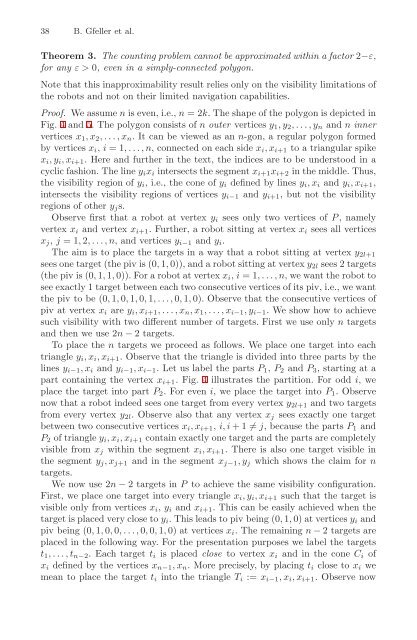Lecture Notes in Computer Science 4837
Lecture Notes in Computer Science 4837
Lecture Notes in Computer Science 4837
Create successful ePaper yourself
Turn your PDF publications into a flip-book with our unique Google optimized e-Paper software.
38 B. Gfeller et al.<br />
Theorem 3. The count<strong>in</strong>g problem cannot be approximated with<strong>in</strong> a factor 2−ε,<br />
for any ε>0, even <strong>in</strong> a simply-connected polygon.<br />
Note that this <strong>in</strong>approximability result relies only on the visibility limitations of<br />
the robots and not on their limited navigation capabilities.<br />
Proof. We assume n is even, i.e., n =2k. The shape of the polygon is depicted <strong>in</strong><br />
Fig. 4 and 5. The polygon consists of n outer vertices y1,y2,...,yn and n <strong>in</strong>ner<br />
vertices x1,x2,...,xn. It can be viewed as an n-gon, a regular polygon formed<br />
by vertices xi, i =1,...,n, connected on each side xi,xi+1 to a triangular spike<br />
xi,yi,xi+1. Here and further <strong>in</strong> the text, the <strong>in</strong>dices are to be understood <strong>in</strong> a<br />
cyclic fashion. The l<strong>in</strong>e yixi <strong>in</strong>tersects the segment xi+1xi+2 <strong>in</strong> the middle. Thus,<br />
the visibility region of yi, i.e., the cone of yi def<strong>in</strong>ed by l<strong>in</strong>es yi,xi and yi,xi+1,<br />
<strong>in</strong>tersects the visibility regions of vertices yi−1 and yi+1, but not the visibility<br />
regions of other yjs.<br />
Observe first that a robot at vertex yi sees only two vertices of P ,namely<br />
vertex xi and vertex xi+1. Further, a robot sitt<strong>in</strong>g at vertex xi sees all vertices<br />
xj, j =1, 2,...,n, and vertices yi−1 and yi.<br />
The aim is to place the targets <strong>in</strong> a way that a robot sitt<strong>in</strong>g at vertex y2l+1<br />
sees one target (the piv is (0, 1, 0)), and a robot sitt<strong>in</strong>g at vertex y2l sees 2 targets<br />
(the piv is (0, 1, 1, 0)). For a robot at vertex xi, i =1,...,n,wewanttherobotto<br />
see exactly 1 target between each two consecutive vertices of its piv, i.e., we want<br />
the piv to be (0, 1, 0, 1, 0, 1,...,0, 1, 0). Observe that the consecutive vertices of<br />
piv at vertex xi are yi,xi+1,...,xn,x1,...,xi−1,yi−1. We show how to achieve<br />
such visibility with two different number of targets. First we use only n targets<br />
and then we use 2n − 2 targets.<br />
To place the n targets we proceed as follows. We place one target <strong>in</strong>to each<br />
triangle yi,xi,xi+1. Observe that the triangle is divided <strong>in</strong>to three parts by the<br />
l<strong>in</strong>es yi−1,xi and yi−1,xi−1. Let us label the parts P1, P2 and P3, start<strong>in</strong>gata<br />
part conta<strong>in</strong><strong>in</strong>g the vertex xi+1. Fig. 4 illustrates the partition. For odd i, we<br />
place the target <strong>in</strong>to part P2. For even i, we place the target <strong>in</strong>to P1. Observe<br />
now that a robot <strong>in</strong>deed sees one target from every vertex y2l+1 and two targets<br />
from every vertex y2l. Observe also that any vertex xj sees exactly one target<br />
between two consecutive vertices xi,xi+1, i, i +1�= j, because the parts P1 and<br />
P2 of triangle yi,xi,xi+1 conta<strong>in</strong> exactly one target and the parts are completely<br />
visible from xj with<strong>in</strong> the segment xi,xi+1. There is also one target visible <strong>in</strong><br />
the segment yj,xj+1 and <strong>in</strong> the segment xj−1,yj which shows the claim for n<br />
targets.<br />
We now use 2n − 2 targets <strong>in</strong> P to achieve the same visibility configuration.<br />
First, we place one target <strong>in</strong>to every triangle xi,yi,xi+1 such that the target is<br />
visible only from vertices xi, yi and xi+1. This can be easily achieved when the<br />
target is placed very close to yi. This leads to piv be<strong>in</strong>g (0, 1, 0) at vertices yi and<br />
piv be<strong>in</strong>g (0, 1, 0, 0,...,0, 0, 1, 0) at vertices xi. The rema<strong>in</strong><strong>in</strong>g n − 2 targets are<br />
placed <strong>in</strong> the follow<strong>in</strong>g way. For the presentation purposes we label the targets<br />
t1,...,tn−2. Each target ti is placed close to vertex xi and <strong>in</strong> the cone Ci of<br />
xi def<strong>in</strong>ed by the vertices xn−1,xn. More precisely, by plac<strong>in</strong>g ti close to xi we<br />
mean to place the target ti <strong>in</strong>to the triangle Ti := xi−1,xi,xi+1. Observe now
















